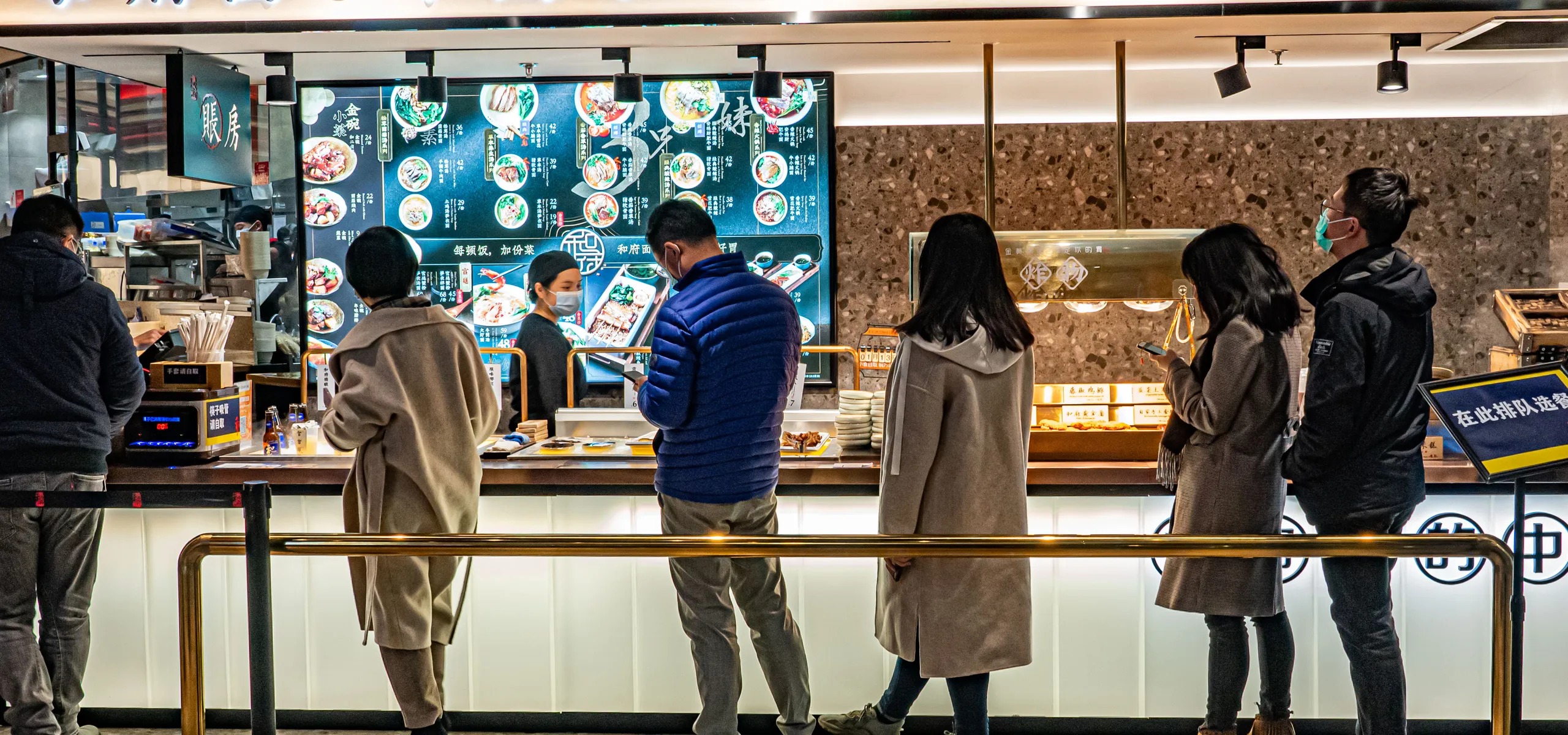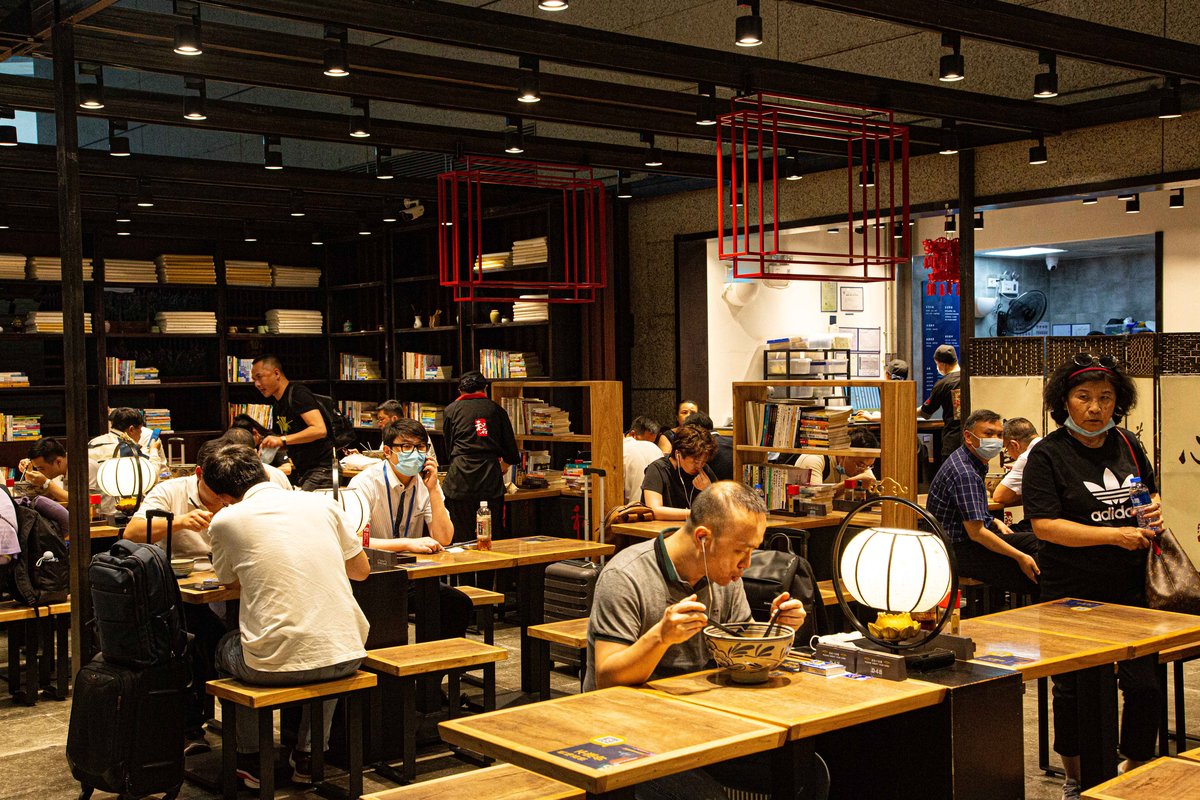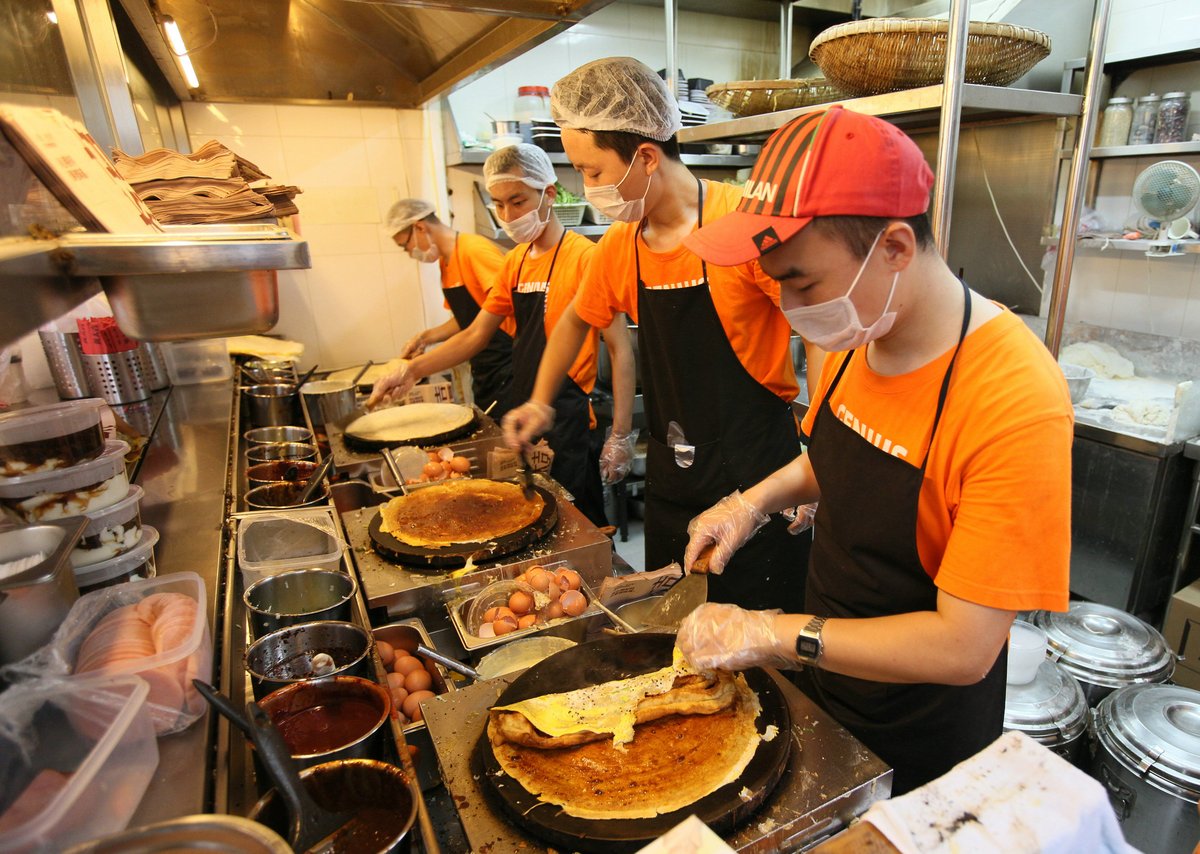Once applauded for their high-end take on classic Chinese dishes, “internet famous” restaurants are now struggling to retain customers
Since the end of “zero-Covid” policies, long lines have returned with a vengeance to China’s popular restaurants. But missing from the line-up are a few chains once hailed as the future of China’s homegrown fast food industry: the Northwest-flavored Bingz, noodle joint Hefu Noodle, beef tripe shop Diao Ye Niu Nan, and pancake restaurant Huang Taiji.
A decade ago, these brands targeted the middle class by selling comfort foods in upscale setting, instead of the usual street stalls and mom-and-pop shops. They charged higher prices than normal, justifying this by setting up inside malls alongside sit-down restaurants and by creating a buzz on the internet. In his viral 2014 WeChat article “Why I Quit My Job to Sell Roujiamo,” former IT worker Meng Bing resonated with many young office workers with his entrepreneurial story of establishing Bingz. Hefu Noodle, on the other hand, stood out by creatively incorporating traditional Chinese decorations such as wooden screens and red lanterns.
Today, though, Zhang Mengling, a Beijing white-collar worker who regularly dines out, dismisses these brands as “so ordinary, yet their prices are so high.” Data from Geo Hey, a brand monitoring website, shows that Hefu Noodle has shut down 275 stores (40 percent of the total) in 2023. It has reduced its prices, previously 40 to 50 yuan a bowl, to just 10 yuan in order to try and halt the exodus of customers like Zhang. Similarly, Bingz has reduced the price of its set meal of rice noodles and roujiamo (a sandwich often compared to a Chinese hamburger) from more than 40 yuan to 15 yuan—what one might expect to pay for such a meal on the street.
Zhang is not alone in complaining about the high prices and disappointing tastes of these “internet famous” fast food joints. A WeChat article titled “People with a Monthly Salary of 20,000 yuan Can’t Afford to Eat Chinese Fast Food” by NetEase Datablog has been read over 80,000 times over the period of less than a month. The article found that for the average white-collar worker in Shanghai, eating two 40-yuan meals a day, five days a week, at one of these stores would mean spending around 1,740 yuan a month, or nearly a quarter of their disposable income. For a white-collar worker in a city like Tianjin, Chengdu, or Wuhan, where incomes are lower, the proportion could be over a third (even after accounting for potentially lower prices in those places).
Furthermore, over 50 percent of people surveyed by iiMedia Research in 2022 believed these restaurants needed to improve the taste of their food; while just under half hoped they would improve their hygiene and food safety.
These cautionary tales already became a reality for Huang Taiji, a fast food restaurant specializing in savory jianbing pancakes that was hailed as “China’s McDonald’s” when it was founded in 2012. Breaking the impression of jianbing being sold in plastic bags at roadside stalls for a few yuan, and eaten on the go, Huang Taiji opened its outlets in shopping malls with jianbing priced at 27 yuan, double or triple the normal price. The brand also extensively marketed itself on social media platforms with catchy slogans like “Eat pancakes, drink tofu pudding, and think about life,” and up-market ads showing the company’s CEO driving a Mercedes to deliver pancakes.
Huang Taiji’s first-year operating income reached 7 million yuan. Within two years of operation, the company’s valuation rose from 40 million yuan to 1.2 billion yuan. But within several months, the profits cooled. The high rental costs in commercial districts and slumping sales meant Huang Taiji shops struggled to survive in a competitive market, and the chain went out of business years ago—the company behind it has even appeared twice on a list of defaulting creditors by Beijing’s Chaoyang District People’s Court.
“The paper bags with patterns and advertising slogans used by Huang Taiji [to package its pancakes] were more attractive than plastic ones used by street vendors,” Zhang admits to TWOC, “but the taste was not. I don’t want to spend so much money on just product packaging.”
In the long term, a greater focus on marketing than on product development seems to have led these brands to a dead end. Li Donglou, founder of market research company Tuolu New Consumption, told Shangyou News in 2021 that these brands’ failure is down to their heavy dependence on gimmicks to attract customers, with no real attention to the quality of the food or innovation of their business models. “No one cares about those pompous brand stories, I just want to eat a bowl of delicious noodles or roujiamo happily,” says Fang Yi, a Beijing college student majoring in management.
Satisfying China’s food-obsessed consumer base may be a tall order for any restaurant. Bingz used to tout its fresh ingredients and food hygiene as selling points, but later began to use pre-prepared dishes that consumers complain are less tasty and nutritious.
”Eating pre-made dishes makes me feel even more like I’m just surviving in the city, not really living,” says Zhang. “I crave pancakes fried on hot iron griddles on the roadside, which look much more appealing than cooking packs heated straight from the fridge.”
China’s fast food market is also highly competitive, with an array of cuisines. Hundreds of varieties of noodle dishes, hot pot, and Western fast food brands like KFC are already available at low prices. Meanwhile, small local eateries and street vendors have already perfected the art of making food that’s fast, tasty, and cheap. The iiMedia Research survey from 2020 showed that about 89 percent of consumers are willing to buy from food stalls.
Local authorities have also rolled out policies to encourage the street stall economy in the last three years, for example by designating particular areas for stalls to do business in and allowing them to stay open late into the night. According to China News Service, so far 27 cities have released formal policies promoting a street vendor economy.
The popularity of places like Zibo, an industrial city in eastern China’s Shandong province that became a viral travel destination this year mainly due to its outdoor barbecue restaurants, suggests smaller eateries still charm consumers with their unpretentious style. “The boisterous atmosphere created by street vendors is a treasure,” says Fang. “I really like it, especially when I feel lonely or stressed. It’s a kind of healing that will never be found in stores located in the shopping mall.”
Perhaps more damaging for these brands are scandals that have reduced consumers’ trust. Hefu Noodle had advertised its use of fresh ingredients such as beef bones, pork bones, tomatoes, and onions in its soup base, which were supposedly boiled at high temperature and stewed at high pressure for a long period so that the nutrients inside the bones can be fully integrated into the soup.
This year, however, an article by Sina.com alleged that Hefu’s broth was cooked from a packet, and quoted an anonymous employee at the company: “Hefu Noodle stores do not have a noodle chef. The noodles are from the factory, the toppings are basically pre-made and only need to be heated, and the soup is made from cooking kits with water added.”
Clawing back those customers won’t be easy, especially since it’s not just noodles that Chinese consumers are cutting back on now. After the Covid-19 pandemic hit household incomes, many consumers are now tightening their belts. China’s central bank, the People’s Bank of China, reported in April this year that 58 percent of residents across 50 cities were choosing to “save more” of their income, while just 23 percent were “spending more.” New trends such as “special forces-style tourism”—where young travelers try to cram as much sightseeing into as short a time as possible to keep their spending low—also reflect consumers’ reluctance to spend.
As a result, diners might not be regretting the decline of fast food chains. “Don’t be fooled by the price reduction—it’s just a return to normal price,” Fang says. Restaurant owners are still looking for a new magic formula where standardization and mechanization can help them capture a potentially huge domestic food market, but for now they seem to have bitten off more than they could chew.















